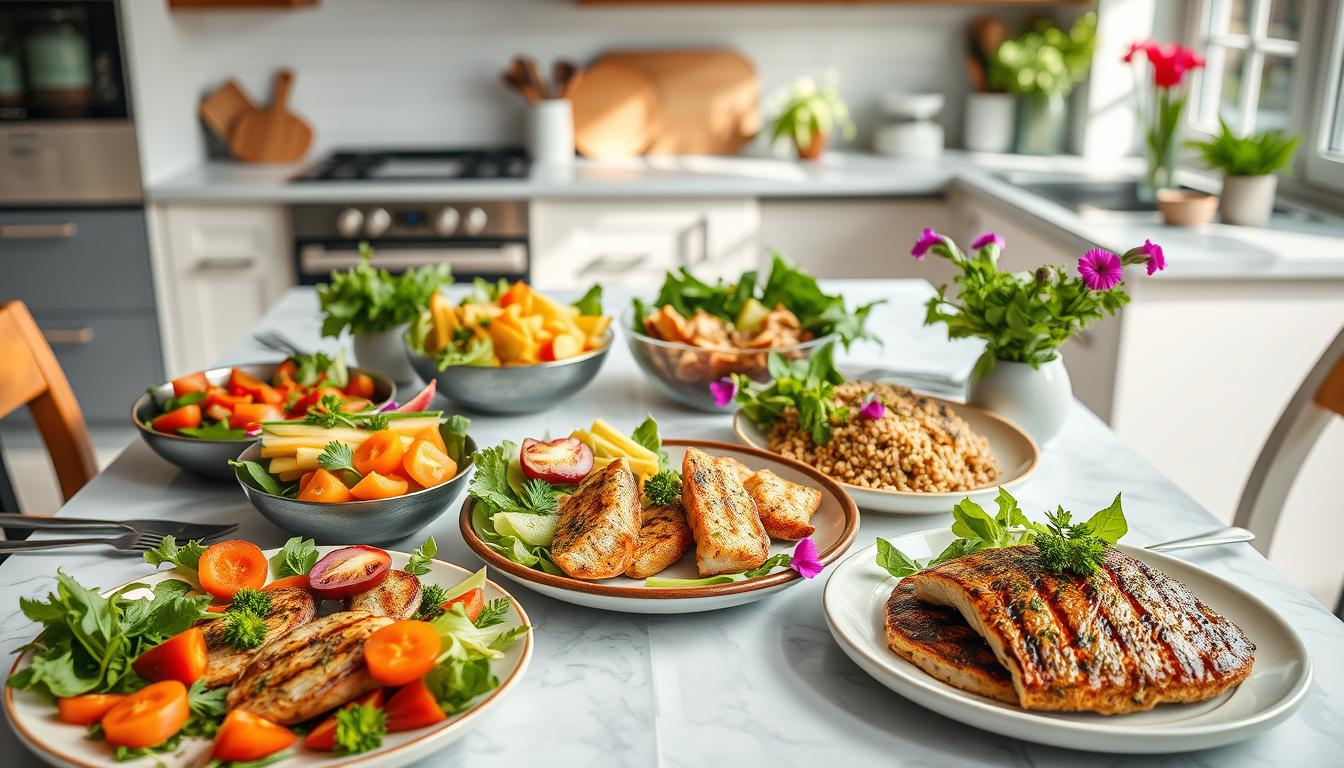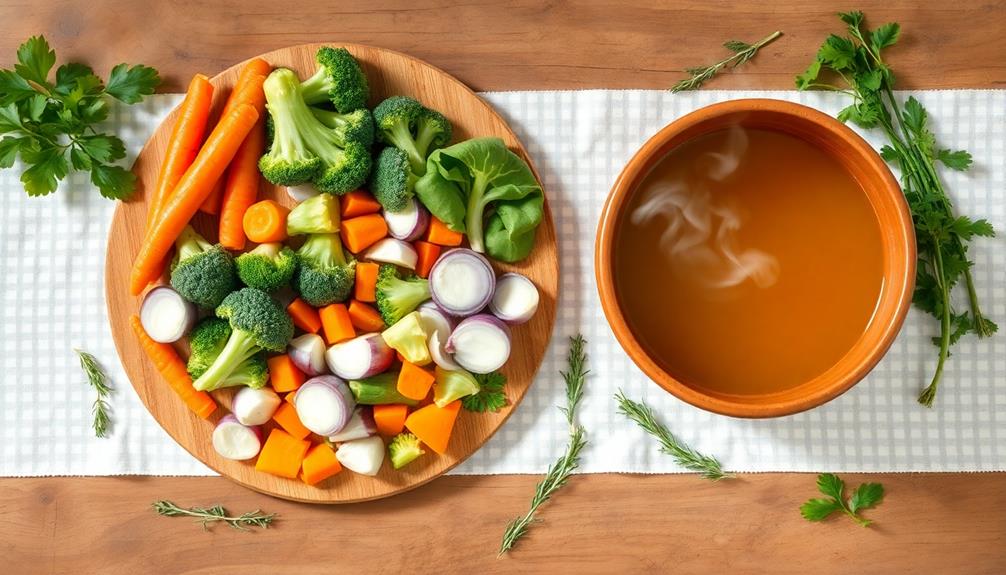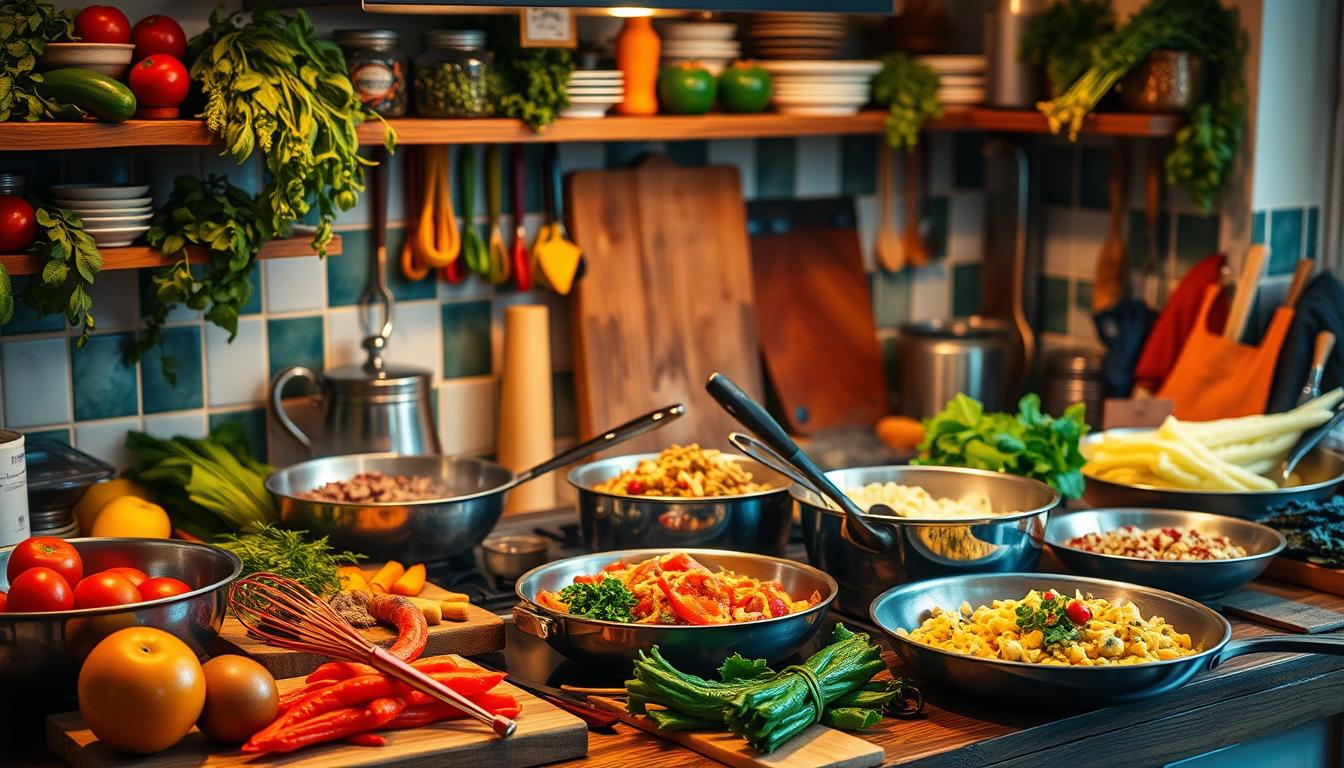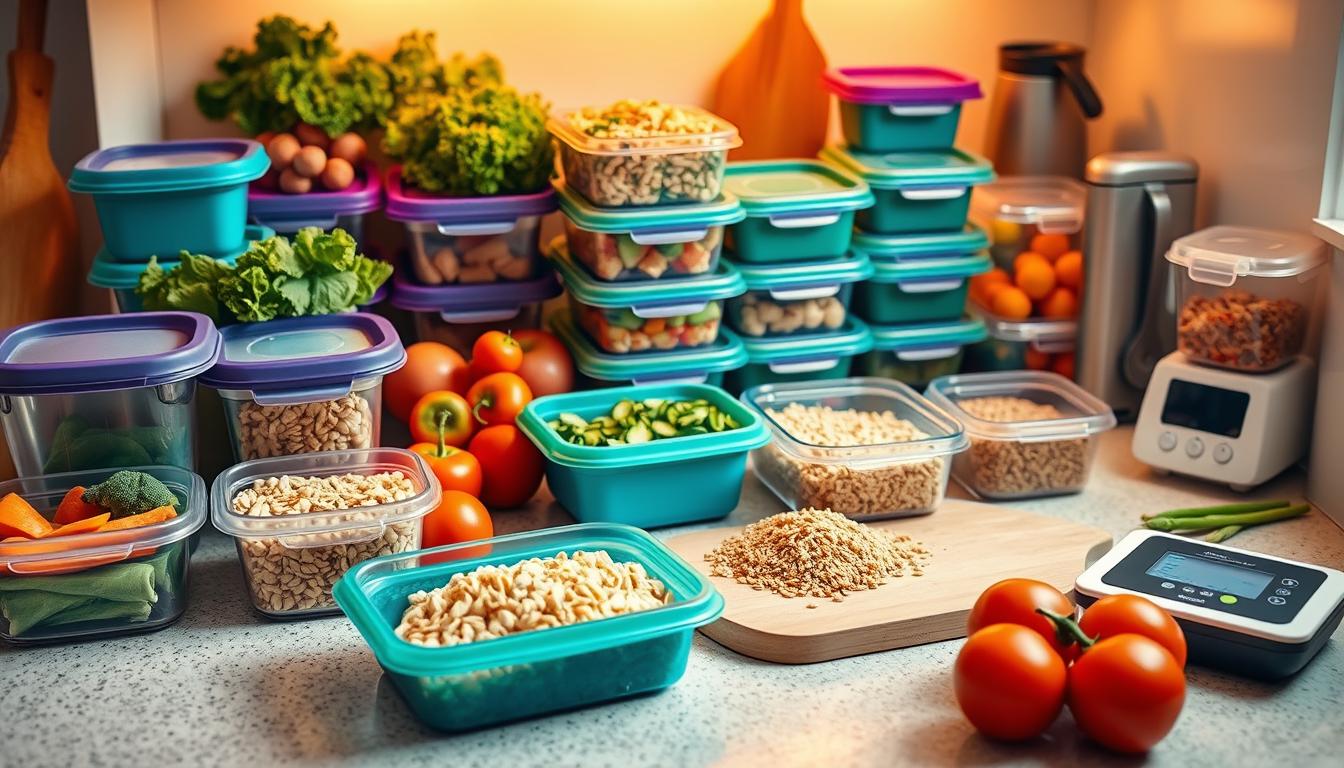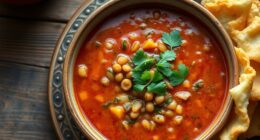Imagine the warmth of laughter filling your home, the aroma of delicious dishes wafting through the air, and the joyful chatter of friends and family gathered around your table. Cooking for a crowd can seem daunting at first, but it is also an opportunity to create memories that last a lifetime. Each dish you prepare carries a piece of your heart—bringing comfort and joy to those you love. Whether it’s a family reunion, a festive holiday gathering, or a backyard barbecue, the thrill of serving a satisfying meal can be deeply rewarding. Armed with the right techniques and tips, you can transform the task of large batch cooking into a delightful experience for both you and your guests. In this section, we’ll explore essential tips and tricks that will help you navigate the world of cooking for a crowd with confidence and ease.
Key Takeaways
- Plan your menu with crowd-friendly recipes to accommodate various tastes.
- Estimate portion sizes accurately; generally, adults eat about 1 pound of food per meal.
- Include a variety of proteins, vegetables, and grains to satisfy all dietary preferences.
- Prepare dessert options with consideration for portion sizes for delightful finishes.
- Incorporate beverages wisely—estimate about 2 drinks per person in the first hour of a gathering.
- Always prepare a little extra food to avoid running out, ensuring everyone feels welcomed.
- Make preparation easier by creating a master shopping list and prepping in advance.
Understanding the Basics of Cooking for a Crowd
Cooking for groups presents unique challenges and rewards that can enhance your social gatherings. The foundation of successful meal planning for a crowd begins with understanding what your guests enjoy. Knowing their preferences helps tailor your menu to suit everyone’s taste buds, creating an inclusive dining experience.
When planning your menu, consider varying your offerings. For instance, if you are hosting a gathering of 25, providing at least four types of appetizers with 6 to 8 pieces per person is advisable. This translates to about 150 to 200 appetizers, a quantity that keeps guests satisfied while ensuring a diverse selection is available.
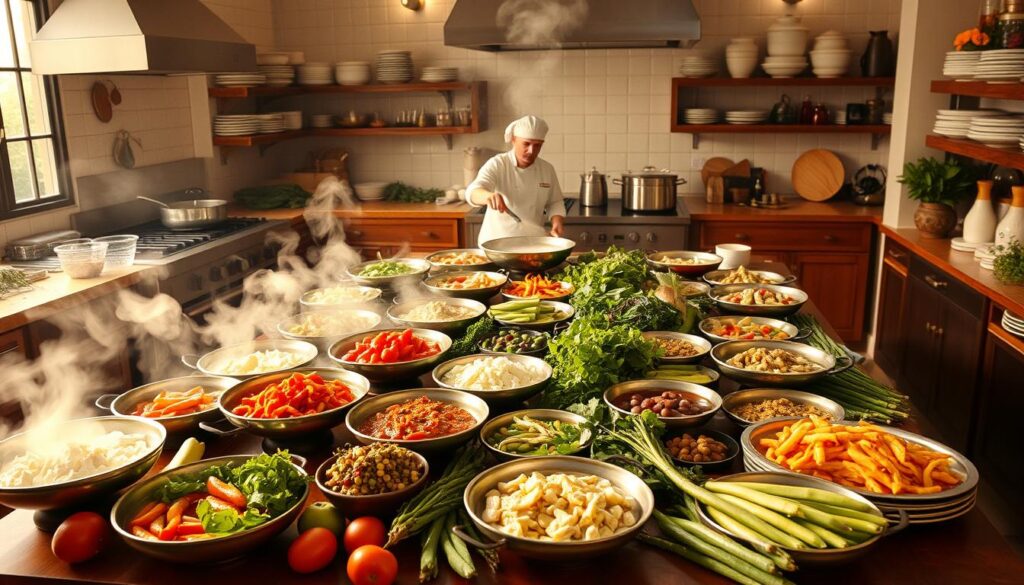
Scaling recipes is pivotal. You should prepare soups at a rate of one cup per person, leading to around 5 quarts for a crowd of 25. For main courses, aim for 1/2 pound of boneless chicken per person, adding up to about 13 pounds for 25 guests. Such estimations enhance your meal planning for a crowd with accurate portions, minimizing waste while maximizing enjoyment.
Logistics play a critical role. Adequate refrigerator and freezer space becomes essential as you prepare larger quantities. Large containers and baking dishes will aid in the mixing process, although don’t forget to consider the additional cooking time that larger recipes may require. When you pay attention to these details, your event will run much smoother, leading to a delightful experience for you and your guests.
Planning Your Menu for Large Groups
Crafting the perfect menu for a gathering requires careful thought about the preferences of your guests and the ingredients you’ll be using. Considerations such as taste and dietary needs play a pivotal role when planning your offerings. Emphasizing easy recipes for a crowd can lead to a successful event, ensuring everyone leaves satisfied.
Know Your Guests’ Preferences
Understanding your guests’ preferences can shape the menu significantly. Are they drawn to familiar, hearty dishes or are they open to trying something new? Asking about dietary restrictions, such as vegetarian or gluten-free options, is essential. This ensures inclusivity and enhances the guest experience while feeding a crowd.
Selecting Seasonal Ingredients
Incorporating seasonal ingredients not only elevates flavor but can also be cost-effective. Planning your meals around what’s in season often leads to better-tasting dishes that receive compliments from your guests. For instance, using fresh tomatoes in a summer pasta can make all the difference.
Balancing Tried-and-True with New Recipes
While classic recipes often please most guests, introducing a few new dishes can add excitement to the menu. For example, including a mix of comforting casseroles and adventurous slow-cooked meals can captivate your audience. This strategy allows you to showcase easy recipes for a crowd while keeping the meal dynamic.

| Dish Type | Description | Benefits |
|---|---|---|
| Appetizers | Small bites to keep guests happy. | Helps manage hunger while waiting for the main meal. |
| Casseroles | One-pot meals made in bulk. | Time-saving and easy to prepare for large groups. |
| Slow Cooked Meals | Dishes like carnitas or shredded beef. | Versatile and customizable, keeping food warm. |
| Pasta Dishes | Lasagna or enchiladas. | Economical and quick to prepare in large quantities. |
| Mini Desserts | Small sweet treats. | Popular and quick to prepare. |
By combining these considerations into your menu planning, you can create an enjoyable experience for everyone involved while efficiently managing the task of feeding a crowd. Your thoughtful approach to meal selection will not only satisfy appetites but will also foster an inviting atmosphere.
Calculating Food Quantities for Big Groups
Preparing for a gathering involves careful calculations to ensure that everyone leaves satisfied. Knowing how to estimate food quantities is especially crucial in big-batch cooking and when cooking for a crowd. This prevents both excessive leftovers and shortages that can disappoint guests.
Estimating Portion Sizes
A good rule of thumb is to plan for about 1 pound of food per adult for all courses. Here’s a quick overview of what to consider based on various group sizes:
| Serving Size | People | Whole Turkey | Baked Beans | Cakes | Whipping Cream |
|---|---|---|---|---|---|
| 25 | 25 | 50 lbs | 5 quarts | 4 | 1 pint |
| 50 | 50 | 100 lbs | 10 quarts | 6 | 2 pints |
| 100 | 100 | 200 lbs | — | — | — |
Considering Dietary Restrictions and Allergies
When planning meals, think about dietary restrictions among your guests. This includes allergies, gluten-free needs, vegetarian choices, and other considerations. By incorporating diverse options, you create an inclusive menu that acknowledges everyone’s preferences.
Allowing for Unexpected Guests
Life can be unpredictable, and having a buffer for unexpected guests is essential. Aim to have an extra 10-20% more food for larger groups. This not only helps address any surprise attendees but also reduces waste by providing guests the option to take home leftovers.
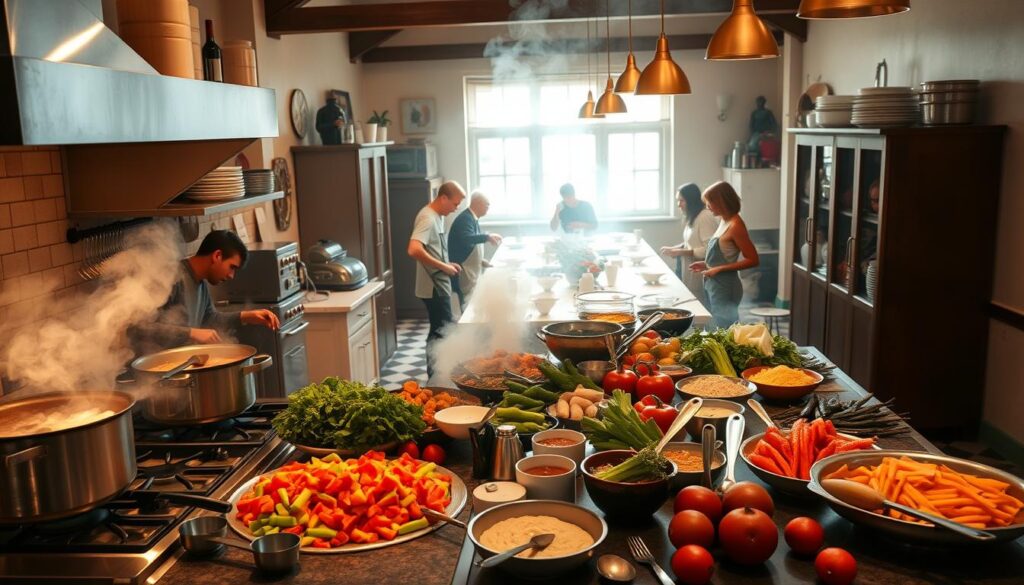
Cooking Techniques for Big-Batch Meals
When it comes to preparing meals for a crowd, mastering specific cooking techniques can make all the difference. You want efficient methods that simplify the process while keeping your food delicious. Utilizing one-pot and one-pan recipes is a fantastic way to streamline your cooking. These methods not only minimize dishwashing but also allow for more time spent with your guests. Embracing casseroles and slow cookers further enhances your ability to cook big-batch meals without the stress of last-minute prep.
Utilizing One-Pot and One-Pan Recipes
One-pot and one-pan recipes offer immense convenience. You can easily combine all ingredients in a single vessel, letting the cooking techniques work their magic. This approach is perfect for crowd-friendly recipes such as:
- Chili
- Pasta dishes
- Stir-fries
- Curry
- Risottos
By integrating various ingredients into one pot, you create layered flavors that impress your guests while reducing cleanup time.
Embracing Casseroles and Slow Cookers
Casseroles and slow cookers are staples in big-batch cooking. They allow for prepare-ahead convenience, letting flavors meld beautifully without requiring constant attention. Some popular options include:
| Dish | Preparation Time | Cook Time |
|---|---|---|
| Lasagna | 30 minutes | 1 hour |
| Pulled Pork | 20 minutes | 8 hours |
| Vegetable Casserole | 25 minutes | 45 minutes |
| Chili | 10 minutes | 4 hours |
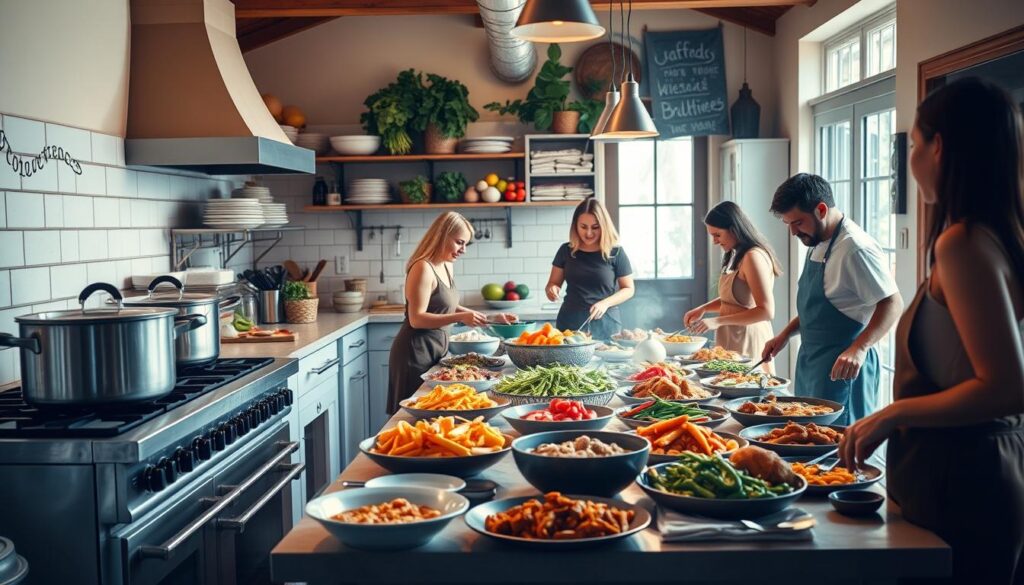
Adopting these cooking techniques not only simplifies meal preparation but also ensures that your big-batch meals are both satisfying and without hassle. You will end up with delightful dishes that keep everyone happy, leaving you more time to enjoy the occasion!
Tips for Efficient Meal Preparation
Efficient meal preparation makes cooking for a crowd manageable and enjoyable. Implementing a strategic approach can help streamline your cooking process, allowing you to focus more on the social experience. Consider following some essential tips to enhance your meal planning for a crowd.
Creating a Schedule for Cooking
Creating a cooking schedule can significantly reduce stress on the day of your event. Begin by listing all the dishes you plan to prepare, noting start times and estimated cooking durations. A timeline ensures that you complete each task sequentially without overlaps.
- List your recipes with cooking times.
- Assign priority to dishes that require longer cook times.
- Create time blocks for each task throughout your cooking day.
Preparing Ingredients in Advance
Preparing ingredients in advance serves as a powerful strategy in the cooking process. Chopping vegetables, marinating proteins, or measuring spices ahead of time can streamline your workflow. This approach not only helps in organizing but also saves valuable time during meal preparation.
- Chop and store vegetables in airtight containers.
- Group ingredients with similar flavors or components for easy access.
- Create a mise en place in your fridge to simplify your cooking day.
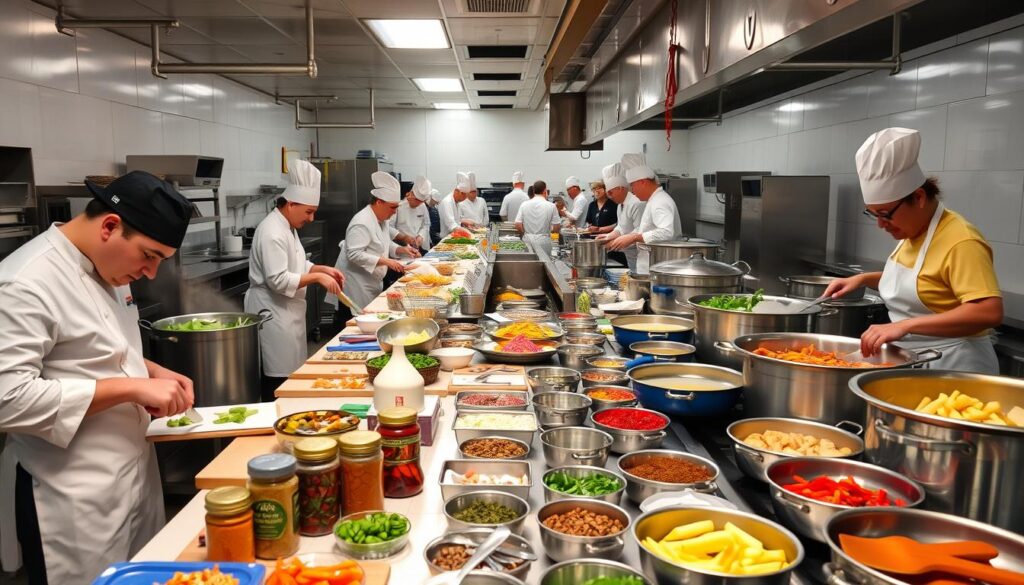
| Preparation Technique | Benefits | Tips |
|---|---|---|
| Batch Cooking | Cook large portions at once | Use a slow cooker or Instant Pot |
| Prepping Ingredients | Saves time on cooking day | Store in reusable airtight containers |
| Creating a Schedule | Organizes your meal prep effort | Use a digital app to share grocery lists |
Strategies for Serving and Presentation
The way you serve food has a significant impact on your guests’ experience. Selecting an appropriate serving style can create a memorable atmosphere and enhance enjoyment. Whether you opt for a buffet, family-style meal, or plated dishes, consider the overall vibe of your gathering. Thoughtful presentation elevates the meal, making it more appealing. Consider how the serving style will align with the theme of your event and the preferences of your guests. For a casual and interactive feel, opt for a family-style setting where guests can pass dishes around and serve themselves. On the other hand, a formal plated meal can create an elegant and sophisticated ambiance. In any case, elevating your meal presentation will leave a lasting impression on your guests and make the dining experience even more enjoyable.
Choosing the Right Serving Style
Choosing a serving style that fits your event can greatly influence the overall experience. A buffet setup encourages mingling and allows guests to help themselves, making it ideal for casual gatherings. Alternatively, family-style serving cultivates a sense of togetherness, while plated meals offer an elegant touch. Consider the comfort and preferences of your guests when making your choice.
Creating an Inviting Buffet Setup
For those focused on feeding a crowd, an inviting buffet is essential. Start by organizing the food items logically, from appetizers through to desserts. Ensure ample space for guests to navigate comfortably. Using various heights in your presentation draws attention and adds visual interest. Brightly colored garnishes not only enhance aesthetics but also enhance taste perception. Studies show that well-presented food can taste 29% better to diners.
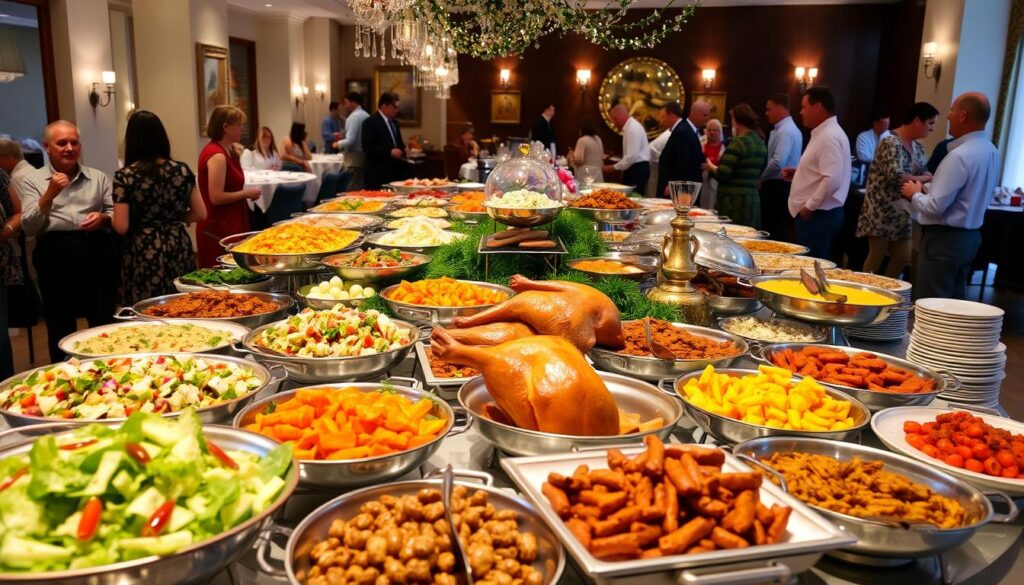
Another technique involves using contrasting colors which makes the display pop. Small but impactful details, such as choosing the right plates and garnishes, can transform a basic meal into an extraordinary dining experience. Equip your buffet with serving tools that reflect the theme of your gathering. These strategies not only improve the visual appeal but also enhance the overall enjoyment of serving food to your guests.
Storing and Handling Leftovers Safely
Managing leftovers is a key aspect of cooking for groups that emphasizes both practicality and food safety. By following fundamental storage practices, you can ensure that your delicious meals remain safe to eat long after the initial gathering.
Best Practices for Storing Leftovers
To maintain the quality and safety of your leftovers, implement these practical guidelines:
- Refrigerate or freeze food within two hours of preparation, or within one hour if the temperature exceeds 90º F.
- Perishable food left at room temperature for more than two hours should be discarded to avoid foodborne illnesses.
- Store leftovers in shallow containers that are three inches tall or less, allowing for rapid cooling.
- Label containers with dates to monitor freshness; consume leftovers within three to four days.
- Before consuming leftover meals, reheat them to an internal temperature of at least 165º F.
- If freezing, leftovers can later be thawed in the refrigerator or immediately in the microwave if you plan to eat them right away.
- Avoid keeping meat, poultry, and fish leftovers in compost to maintain safety and minimize pest attraction.
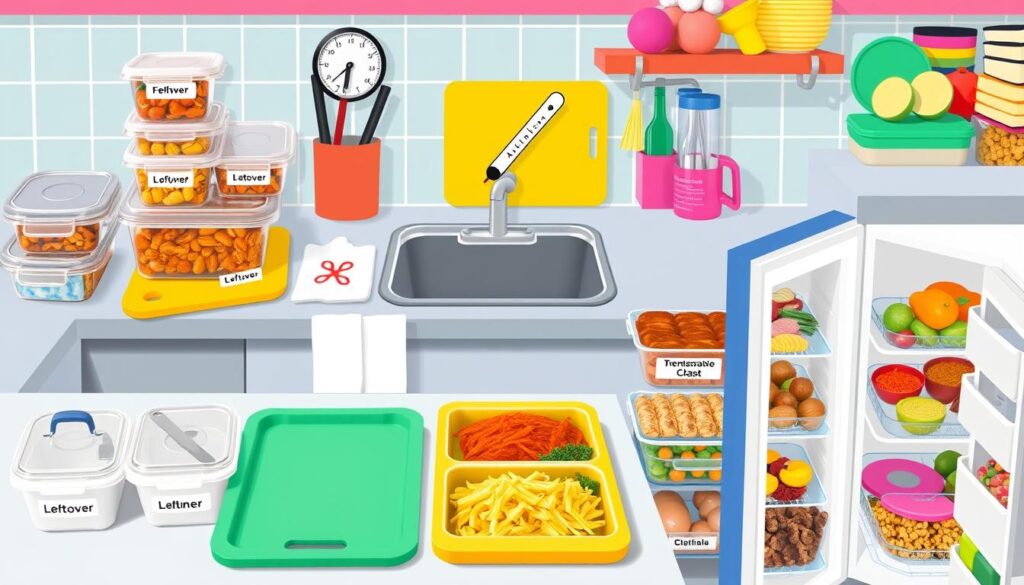
Properly handling leftovers not only helps to reduce waste but also supports food safety protocols. If a leftover item appears or smells unusual, it is best to err on the side of caution and dispose of it. Remember, the risk of foodborne illness increases the longer food remains in the “danger zone”, which is between 40 and 140 degrees Fahrenheit. With these best practices, you can enjoy your leftovers safely and deliciously.
Outdoor Cooking for a Crowd
Outdoor cooking for a crowd offers a perfect way to enjoy delicious meals while soaking up the sunshine. Adapting traditional recipes for the grill can enhance flavors and bring excitement to any gathering. Big-batch cooking is essential for these occasions, allowing you to prepare hearty dishes that satisfy everyone.
Adapting Recipes for Grilling
Transforming classic recipes into grilling masterpieces involves creative substitutions and techniques. Focusing on local favorites can make your outdoor feast stand out. For instance, consider incorporating flavors from various regions, such as:
- Bacon cheeseburger pasta from Fort Morgan, Colorado
- Spicy jalapenos featured in dishes from Tucson, Arizona
- Sweet and smoky barbecue sauce that hails from South Carolina
Grilling not only adds a distinct flavor but also makes cooking a social event. Preparing dishes like foil pack entrees and Dutch oven recipes allows for easy serving, minimizing cleanup.
Planning for Outdoor Buffets
Setting up for an outdoor buffet requires thoughtful considerations. Arranging tables and seating comfortably can enhance guests’ experiences while ensuring food safety. Keep in mind these elements for successful outdoor cooking for a crowd:
- Create designated areas for food and seating.
- Provide coolers for perishable items and beverages.
- Utilize non-perishable staples, like canned goods and dry ingredients, to reduce the need for refrigeration.
By planning ahead, you can create an enjoyable atmosphere while ensuring that every dish remains safe and flavorful throughout the event. The combination of outdoor cooking techniques and thoughtful preparation will ensure a memorable gathering.

| Recipe Name | Location Inspiration | Main Ingredients |
|---|---|---|
| Bacon Cheeseburger Pasta | Fort Morgan, Colorado | Pasta, bacon, ground beef, cheese |
| Spicy Jalapeno Skewers | Tucson, Arizona | Fresh jalapenos, marinated chicken |
| Sweet and Smoky BBQ Ribs | Spartanburg, South Carolina | Ribs, barbecue sauce, spices |
| Dutch Oven Chili | Watertown, South Dakota | Ground beef, beans, tomatoes, spices |
Cooking for a Crowd: Final Considerations
Before embarking on the adventure of cooking for a crowd, you should keep several important factors in mind. Start by double-checking your guest count. Accurate numbers help streamline your meal planning process. Having everything prepared will lead to a smoother cooking experience.
Review your menu plan based on the ingredients you have on hand and any specific dietary restrictions expressed by your guests. Your menu may benefit from a flexible approach, allowing you to substitute staples or seasonal items. For instance, if you’re hosting a gathering in October, consider incorporating seasonal ingredients alongside the main course, like two rotisserie chickens, for a well-rounded meal.
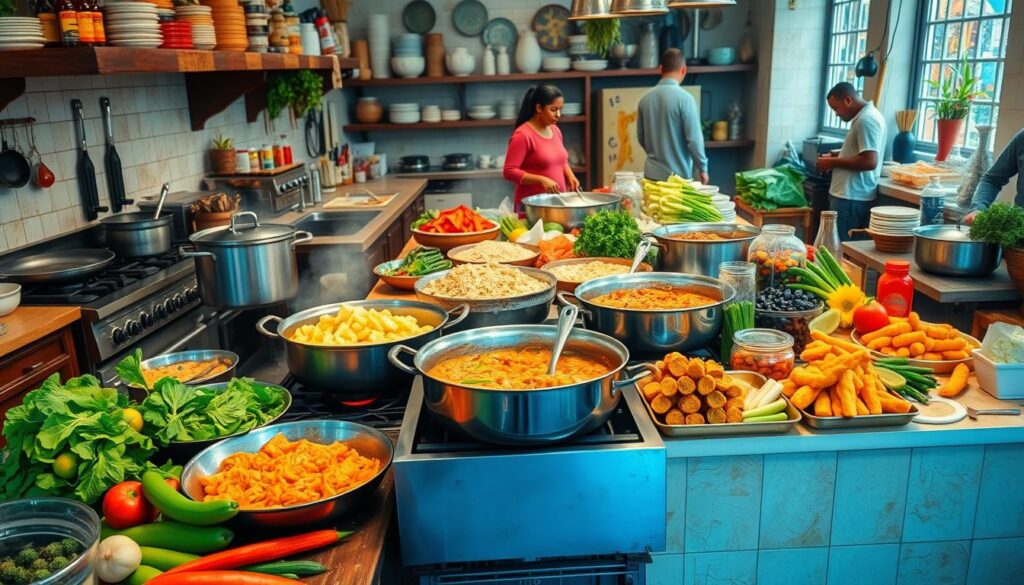
As you consider appetizers, think about a variety of flavors with items like olives, cheeses, crackers, cured meats, and pickles. Don’t forget about serving sides that appeal to all, like a colorful tomato salad made from approximately 1.5 to 2 pounds of cherry tomatoes. Including fresh herbs such as dill, parsley, basil, mint, or cilantro enhances the taste and presentation of your dishes.
Planning for potluck gatherings adds another layer of complexity. Communicate with guests about what they plan to bring to avoid duplication. Encourage inclusivity by respecting dietary preferences, whether someone is vegan, gluten-free, or has other restrictions. Educating your guests about potluck etiquette ensures all attendees feel welcome and accommodated.
The focus of the gathering should center on enjoying the moment with your friends and family rather than solely on the food. Keep in mind that large, deep bowls of soup, stew, or cooked meat or poultry take time to cool down to a safe temperature. Aim to serve your meals promptly and remember that generally cooked food can be safely kept for around 3-4 days. By planning carefully, you can create a delicious and memorable event that everyone will appreciate.
| Considerations | Details |
|---|---|
| Guest Count | Always double-check to ensure accurate meal planning. |
| Menu Plan | Review dietary restrictions and be willing to substitute ingredients. |
| Main Course | Two rotisserie chickens recommended. |
| Appetizer Ideas | Include olives, cheeses, crackers, cured meats, and pickles. |
| Tomato Salad | Use approximately 1.5 to 2 pounds of cherry tomatoes. |
| Fresh Herbs | Dill, parsley, basil, mint, or cilantro can elevate your dishes. |
| Potluck Etiquette | Encourage great communication about what guests will bring. |
Conclusion
Cooking for a crowd is not just a task, but a rewarding opportunity to create connections and share experiences over food. With thoughtful meal planning for a crowd, you can offer dishes that cater to diverse tastes while also being mindful of dietary restrictions. The key is to stay organized and embrace practical cooking techniques that facilitate a smooth preparation process.
Reflecting on the joy experienced during the recent charity event, where a catered lunch resulted in happy residents and minimal leftovers, it’s clear that well-prepared meals can significantly enhance any gathering. The engaging bingo game, characterized by practical choices—like the story of Steve selecting an umbrella and lunch box—illustrates that meaningful moments often arise when we prioritize both practicality and enjoyment.
Ultimately, the goal of cooking for a crowd transcends mere meal preparation; it’s about fostering a sense of community and connection through shared meals. Embrace the strategies discussed, and you’ll be well-equipped to host successful gatherings that leave everyone feeling satisfied and appreciated.

